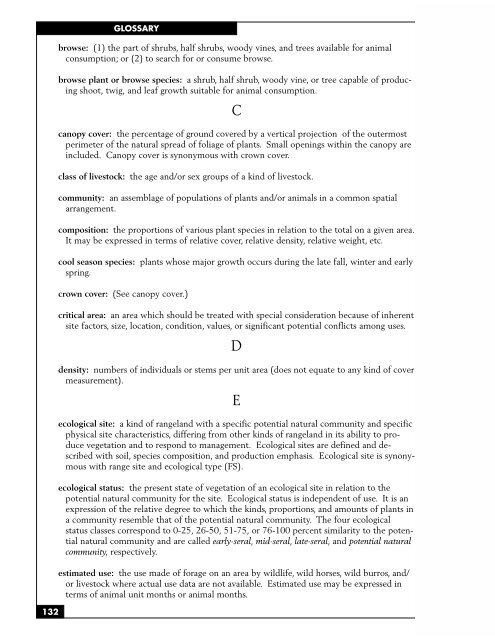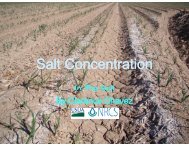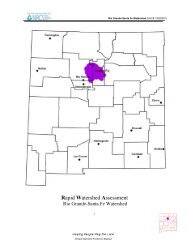SAMPLING VEGETATION ATTRIBUTES - New Mexico NRCS - US ...
SAMPLING VEGETATION ATTRIBUTES - New Mexico NRCS - US ...
SAMPLING VEGETATION ATTRIBUTES - New Mexico NRCS - US ...
You also want an ePaper? Increase the reach of your titles
YUMPU automatically turns print PDFs into web optimized ePapers that Google loves.
132<br />
GLOSSARY<br />
browse: (1) the part of shrubs, half shrubs, woody vines, and trees available for animal<br />
consumption; or (2) to search for or consume browse.<br />
browse plant or browse species: a shrub, half shrub, woody vine, or tree capable of producing<br />
shoot, twig, and leaf growth suitable for animal consumption.<br />
C<br />
canopy cover: the percentage of ground covered by a vertical projection of the outermost<br />
perimeter of the natural spread of foliage of plants. Small openings within the canopy are<br />
included. Canopy cover is synonymous with crown cover.<br />
class of livestock: the age and/or sex groups of a kind of livestock.<br />
community: an assemblage of populations of plants and/or animals in a common spatial<br />
arrangement.<br />
composition: the proportions of various plant species in relation to the total on a given area.<br />
It may be expressed in terms of relative cover, relative density, relative weight, etc.<br />
cool season species: plants whose major growth occurs during the late fall, winter and early<br />
spring.<br />
crown cover: (See canopy cover.)<br />
critical area: an area which should be treated with special consideration because of inherent<br />
site factors, size, location, condition, values, or significant potential conflicts among uses.<br />
D<br />
density: numbers of individuals or stems per unit area (does not equate to any kind of cover<br />
measurement).<br />
E<br />
ecological site: a kind of rangeland with a specific potential natural community and specific<br />
physical site characteristics, differing from other kinds of rangeland in its ability to produce<br />
vegetation and to respond to management. Ecological sites are defined and described<br />
with soil, species composition, and production emphasis. Ecological site is synonymous<br />
with range site and ecological type (FS).<br />
ecological status: the present state of vegetation of an ecological site in relation to the<br />
potential natural community for the site. Ecological status is independent of use. It is an<br />
expression of the relative degree to which the kinds, proportions, and amounts of plants in<br />
a community resemble that of the potential natural community. The four ecological<br />
status classes correspond to 0-25, 26-50, 51-75, or 76-100 percent similarity to the potential<br />
natural community and are called early-seral, mid-seral, late-seral, and potential natural<br />
community, respectively.<br />
estimated use: the use made of forage on an area by wildlife, wild horses, wild burros, and/<br />
or livestock where actual use data are not available. Estimated use may be expressed in<br />
terms of animal unit months or animal months.




